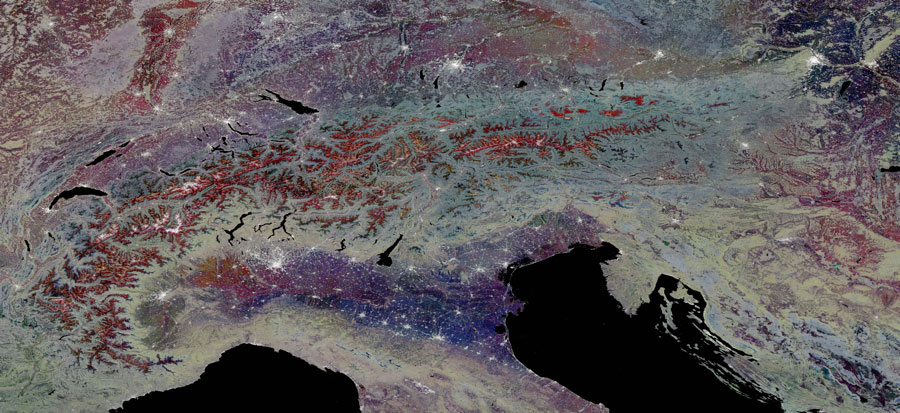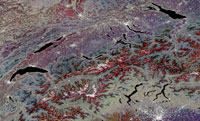Accurate characterisation of snow melting enables a better understanding of hydrological conditions. The Copernicus Sentinel-1 satellites can be used to provide such information in a timely fashion. They help to improve maps that show which areas are susceptible to increased water run-off, therefore contributing to flood risk management.
Scientists of the University of Zurich processed and analysed acquisitions from the Copernicus Sentinel-1 satellites to characterise snow melting areas in the Alps and over the Arctic. Examples of their results are presented here.
They developed a new technique to generate wide-area radar backscatter mosaics, whereby radiometric artefacts caused by terrain are corrected before merging all available images into a single composite.
This technique provides for the first time views of temporal changes across multiple radar swaths, also in the presence of strong topography. A Digital Elevation Model (DEM) from the Shuttle Radar Topography Mission (SRTM) was used as input during the terrain-flattening and geocoding procedures over the Alps.
The first video featured here represents backscatter composite of the Alps over a full year: 16 August 2016 – 16 August 2017. It was obtained using available images from both Sentinel-1A and -1B satellites, in VH-polarisation, applying a 12-day temporal window with 6-day steps.
With a resolution of 90 m, it shows melting (dark, wet snow backscatter signature) visible at low elevations in early springtime. By summer wet snow is left only near the highest peaks.
These high peaks retained bright backscatter signatures in early spring (dry snow is not dark), darkening only once the last remnants of snow began to melt in the summer. The corrections for terrain [1] combined with the compositing strongly reduce the effects of foreshortening/layover and radar shadow on the backscatter maps. These corrections also ensure that the swaths of individual single-track acquisitions are usually not visible in the composite.
Extremely bright echoes caused by radiofrequency interference (RFI) are occasionally visible, for instance over southern Germany.
By overlaying three different composite backscatter maps as Red-Green-Blue (RGB) channels, one clearly sees the seasonal progression in snow melting. The image shows backscatter from the 16 days following 02 March 2017 in red, 01 April in green, and 01 May in blue.
Urban areas are consistently bright (white), while water bodies are consistently dark (black). Regions with seasonal dynamics show a colour, for instance, reddish indicates areas that were bright in March, but persistently dark in April and May. The highest peaks appear white, as their dry snow was never melting, neither in March, April, nor May. The close-up (second image) shows how both sides of the steepest mountains in the Alps are mapped regularly, with the typical SAR artefacts from layover/shadow absent.
By calculating the ratio between springtime composite images and wintertime dry reference ones wet snow regions are mapped [2].
A mean "dry" reference image is calculated from the wintertime composite backscatter maps, and then each "frame" of the Alpine composite backscatter video is compared, to classify pixels as wet or dry [2]. The classification result can then be provided as an input to hydrological models.
The second video presents an unprecedented combination of simultaneously high temporal and spatial resolution of Arctic melting (in comparison to previous retrievals based on passive microwave signatures), observed in backscatter composites over Ellesmere Island, Canada and north-western Greenland, including the Nares strait that divides them. The region shown is comparable in size to the British Isles, that is to say much larger than a single Sentinel 1 track, even the widest "EW" (extended wide) beam.
Composites were formed using available images from both of the Sentinel-1 satellites, in HV-polarisation, created with 2-day temporal window with 1-day steps, at 400 m resolution. As no SRTM DEM is available over the Arctic, a Canadian DEM was used for processing the Arctic data [3].
These backscatter composites offer an overview of wide regions. In comparison to the standard level 1 "slant range" or "ground range" products available from the Copernicus data hub, the backscatter composites provide wider coverage, and their time series are simpler to understand by non-radar specialists.
The two-day temporal window over Ellesmere Island is the shortest with full coverage so far ever achieved - as Dr David Small of the University of Zurich says, "If one were able to combine data from Europe's Sentinel-1 and Canada's (CSA) RCM satellites in the future, one could potentially generate such composites even with daily temporal resolution, also at lower latitudes."
The video features melting on ice caps (dark wet snow backscatter signature) visible in the short summer during warmer periods (intermittent melting/thawing visible). The movement of ice out to the Atlantic through the Nares strait between Ellesmere Island and Greenland is visible in May-June 2017.
About the Sentinels
The Sentinels are a fleet of dedicated EU-owned satellites, designed to deliver the wealth of data and imagery that are central to Europe's Copernicus environmental programme.
In partnership with EU Member States, the European Commission leads and coordinates this programme, to improve the management of the environment, safeguarding lives every day. ESA is in charge of the space component, responsible for developing the family of Copernicus Sentinel satellites and ensuring the flow of data for the Copernicus services, while the operations of the Sentinels have been entrusted to ESA and EUMETSAT.
Acknowledgments: Support from ESA's Sentinel-1 Data Quality Manager Nuno Miranda, and ESA IDEAS+ Contract No. VEGA/AG/15/01757
UZH contributions: Dr David Small, Christoph Rohner, David Jäger, Dr Adrian Schubert
[1] D. Small, "Flattening Gamma: Radiometric Terrain Correction for SAR Imagery," IEEE Trans. Geosci. Remote Sens., vol. 49, no. 8, pp. 3081–3093, Aug. 2011.
[2] D. Jäger, Wide-area wet snow mapping of the Alps based on Sentinel-1 multi-track radar backscatter composites, M.Sc. Thesis, University of Zurich, 2016.
[3] M. Santoro & T. Strozzi (2012): Circumpolar digital elevation models > 55° N, PANGAEA, doi: 10.1594/PANGAEA.779748



